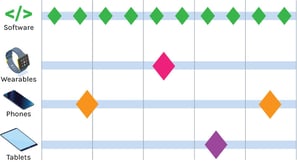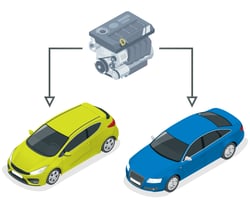 Increasing efficiency within your organization's product development process does not come in a one-size-fits-all solution. Each industry has unique challenges to launching the next best product. The product development approach best suited to your organization will depend on the size of your company, the complexity of your product lines, and your mindset for success.
Increasing efficiency within your organization's product development process does not come in a one-size-fits-all solution. Each industry has unique challenges to launching the next best product. The product development approach best suited to your organization will depend on the size of your company, the complexity of your product lines, and your mindset for success.
Most manufacturing companies are adapting to the shifting landscape of product development by adopting a hybrid methodology (a mix of agile and stage-gate) or completely embracing agile methods. The rapid pace of innovation drives the need to increase flexibility in defining product lines. Shifting consumer demand, global affairs, and technological developments favor those companies that can adapt quickly to meet the needs and wants of the market the fastest. The ability to test a minimum viable product and refine it before the launch can save a company significant amounts of time and money.
Regardless of which product development method your organization is using, there are further layers to your approach that will influence how effective your product development teams can be. Companies creating cyber-physical products and systems (integrating software into physical components) can benefit from the software development strategy of product line engineering or PLE.
The Benefits of Feature-Based Product Line Engineering (PLE)
 The term PLE was coined in the eighties with a focus on designing and developing software systems. With the lines between hardware and software blurring more and more each year, PLE is no longer a strategy associated only with software systems. While they may not have been calling it "PLE," manufacturers of complex products—think automobiles, airplanes, communication infrastructure—have long been using a strategy similar to PLE, even before the term was coined.
The term PLE was coined in the eighties with a focus on designing and developing software systems. With the lines between hardware and software blurring more and more each year, PLE is no longer a strategy associated only with software systems. While they may not have been calling it "PLE," manufacturers of complex products—think automobiles, airplanes, communication infrastructure—have long been using a strategy similar to PLE, even before the term was coined.
In 2024, manufacturers are using PLE to manage the integration of their software components with their hardware components to create new types of product lines. The overall concept remains the same: design and define a line of products by the features they have in common and the ones that are unique. The exceptional detail is that your product managers are now overseeing a wide range of components coming together on various timelines, with separate goals that must combine to meet an overarching purpose.
Even with this level of complexity in product manufacturing, there are defining benefits of PLE that include:
Reduced Development Costs
Reusing common components between models in a product line helps save on the costs of developing independent components from scratch.
Increased Quality
When less time is spent on developing components from scratch, more time can be spent improving the quality of the components shared across the product line.
Faster Time-to-Market
Sharing components helps to streamline the development process, which speeds up the time it takes to get a new product to the market.
Increased Flexibility
Shared components give product line engineers greater flexibility to adapt to changing market conditions by customizing the variant features to match customer demands.
How to Manage Your Product Line Features Using PRM Software
 Because PLE focuses on features, your product teams need access to software that is designed to display feature details. When your product manager can glance at a product line and see clearly which features are in use across the product line and which features are unique to each model, they can make faster decisions.
Because PLE focuses on features, your product teams need access to software that is designed to display feature details. When your product manager can glance at a product line and see clearly which features are in use across the product line and which features are unique to each model, they can make faster decisions.
For example, when a particular battery in a product line of laptops is getting ready to phase out over the next two years, the product manager needs to know how many models will be impacted by this plan. They'll also need to source a replacement battery and ensure it's in production and ready to launch in each impacted product model before the phase-out finishes.
Rather than spending hours talking to each product owner and engineering team to learn whether or not they're using the same battery, product managers can save time by using a digital tool such as our Gocious PRM Software. By opening their product line dashboard, they can analyze their product lines and see right away which models will be affected.
Here are some additional ways the right product roadmapping management software can support your PLE efforts.
Product Modeling
The fundamental strategy of PLE is feature modeling. This involves identifying the features that contribute to a product and mapping out their common use, or potential common use, in the product line.
Mapping out features helps product teams identify and highlight opportunities where a particular component can be used in multiple product variants. With product roadmap software, product managers can receive ideas, score features, and prioritize the next best solution for the product variant and product line.
Analysis of Commonalities and Variabilities
 Product Roadmap Management software also makes it easy for product managers to share useful information regarding an entire product line's feature list (including commonalities and variabilities). Knowing what is in use and where it is makes product management more effective.
Product Roadmap Management software also makes it easy for product managers to share useful information regarding an entire product line's feature list (including commonalities and variabilities). Knowing what is in use and where it is makes product management more effective.
Because PLE focuses on analyzing commonalities and variabilities within a product line, innovative software helps keep all information current and in a central location accessible by all who need it—maintaining a single source of truth.
Product Configuration
When planning a new product, knowing which common features are available and which unique features are needed helps define the product process. It also helps define the difference between products and clarify future product planning.
Imagine your product teams using a visually clear template to configure products based on selected features and score those ideas to find the next best solution to launch. This is possible using product roadmap management software. Product managers can generate different proproduct configurations by choosing and combining feature possibilities.
Product Line Architecture
A key component of PLE is product line architecture or PLA. The goal of PLA is to create multiple products by combining and customizing a set of shared components. When companies launch a new line of products, it's easier to define and plan a flexible architecture using a roadmap. When they have a high-level overview of an entire product line, it's easier to link common components and clearly communicate the modular features.
Building successful product lines also requires knowing when to add a new product to meet an opportunity in the market and when to sunset a product that is no longer required. Tracking and planning these decisions becomes easier with alerts, milestones tracking, and easy communication with other stakeholders. Product roadmapping features in Gocious PRM software allow product managers to do all this.
Product Roadmap Management Software for PLE
Gocious product roadmap management software is the only tool you need to manage your product roadmaps and facilitate your PLE planning. Create, plan, and manage your product lines in a single source of truth your stakeholders can understand. Book your free demo to see how Gocious software can transform product management in your organization.


